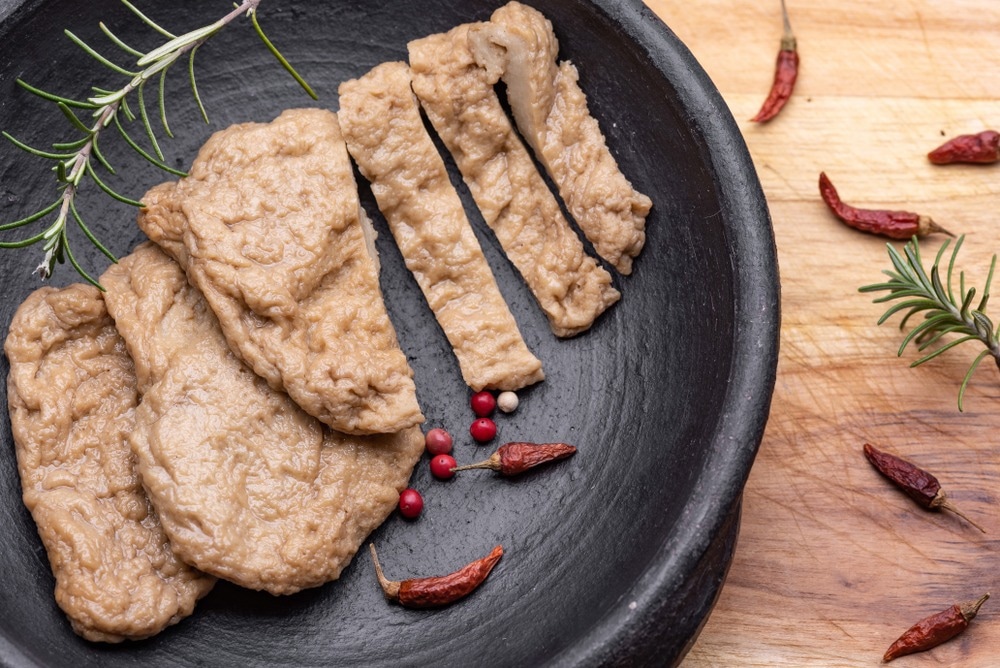Writing in the journal LWT, a team of scientists from the Warsaw University of Life Science-SGGW’s Department of Technique and Food Development has presented the findings of research into a new, innovative meat analog with enhanced antioxidant value.

Study: The optimization of a gluten-free and soy-free plant-based meat analogue recipe enriched with anthocyanins microcapsules. Image Credit: RcriStudio/Shutterstock.com
Plant-Based Meat Analogs: A Growing Food Trend
Many people have switched to a diet that contains less or no animal products in recent years as they have become aware of the environmental impact of the meat industry as well as the ethical and potential health issues of animal product consumption.
However, there are several vital ingredients in meat that are difficult to replicate in analogs or so-called fake meats. Accurately replicating these ingredients is crucial for a healthy balanced diet for individuals who have consciously chosen a plant-based diet.
Animal meat contains all the amino acids necessary for healthy development, including those which the body cannot produce: valine, leucine, threonine, lysine, isoleucine, tryptophan, methionine, and phenylalanine. It is also a key source of vitamin B1, with 100g of pork products providing 50% of the daily recommended amount. Moreover, meat contains vitamin B12, which is not present in plants.
B12 is important for stress resistance, long-term mental health, and protection against degenerative conditions such as Alzheimer’s disease. Meat, especially red meat like beef, is an extremely important source of heme iron, which can be more easily digested by the body than non-heme iron found in plants. Iron is vital for biological functions such as the healthy production of hemoglobin.
Animal meat is a source of creatine, which is essential for producing energy for muscles, which beef, turkey breast, and pork contain in ample amounts. Synthesizing the vital ingredients in animal products is a key challenge for the plant-based meat analog industry. Nevertheless, with the growing trend in consumer demand for meat alternatives, overcoming these challenges is a key research focus.
Meeting Consumer Demands for Texture and Flavor
Whilst there is a growing trend of giving up meat consumption, many individuals who are transitioning to plant-based diets for ethical, health, and environmental reasons still enjoy the taste and texture of animal products. The number of consumers completely replacing meat in their diet is still relatively small.
The growing trend of “flexitarianism” where consumers seek to significantly reduce their meat consumption rather than giving up entirely, is a driver of the development of meat substitutes. Market analysis has revealed that the flexitarian diet is one of the largest global nutritional trends.
Replicating the flavor and texture of meat products is a key concern for producers seeking to serve current market trends. Seasoning is commonly used to give plant-based meat substitutes their characteristic “meaty” flavor. Several ingredients have been explored to replicate the texture of meat, with soy and wheat gluten being widely used in meat analogs.
Whilst soy and wheat gluten can duplicate the texture of animal meats, a key concern with their use in substitutes is their allergenicity. Thirty-nine percent of consumers in the US alone avoid products containing gluten, and 22% avoid soy-based products. Another key demand is the manufacture of products with functional qualities such as antioxidant properties and enriched nutrition.
The Study
The authors behind the study have focused on the production of soy- and gluten-free plant-based meat analogs enriched with microcapsules containing anthocyanins, which are potent antioxidants. The optimized recipe includes pea protein isolate, chickpea flour, potato starch, xanthan gum, rapeseed oil, citrus and apple pectin, spices, and water. Anthocyanins were extracted from dried ground chokeberry fruits.
Dry ingredients were prepared and mixed at room temperature for ten minutes until a homogenous consistency was achieved and then combined with a gelling emulsion of thickening agents. The final product was formed into patties using a mechanical press and baked for ten minutes at 180oC. Physiochemical analysis was performed once the patties were cooled to room temperature.
Rheological properties, texture profile, color parameters, antioxidant activity, and total phenolic content of the prepared product were analyzed. Additionally, sensory evaluation was conducted to provide information on the overall consumer acceptance of the meat substitute. Appearance, aroma, color, taste, texture, juiciness, and overall acceptability were evaluated on a panel of sixty volunteers.
Analysis revealed the optimal dosage of water, gelling agents, and microencapsulated anthocyanins, which are 52.19%, 1.59%, and 2.74%, respectively. Incorporation of microencapsulated anthocyanin enhances antioxidant properties as well as causes an acceptable color change in the product. Sufficient rheological and textural parameters are achieved using optimal water and gelling agent proportions.
The product presented in the research is similar to the physiochemical parameters of animal meat, with high sensory acceptance as well as antioxidant properties. The absence of soy and gluten, which are recognized allergens, helps to fill a niche in the market that is currently under-served.
It is hoped by the researchers that the production technology and recipe presented in the research will see successful use in the food industry and increase the market share of vegan products.
More from AZoM: A Closer Look at Semiconductor Test Equipment
Further Reading
Szpicer, A et al. (2022) The optimization of a gluten-free and soy-free plant-based meat analogue recipe enriched with anthocyanins microcapsules LWT 113849 [online, pre-proof] sciencedirect.com. Available at:
Disclaimer: The views expressed here are those of the author expressed in their private capacity and do not necessarily represent the views of AZoM.com Limited T/A AZoNetwork the owner and operator of this website. This disclaimer forms part of the Terms and conditions of use of this website.